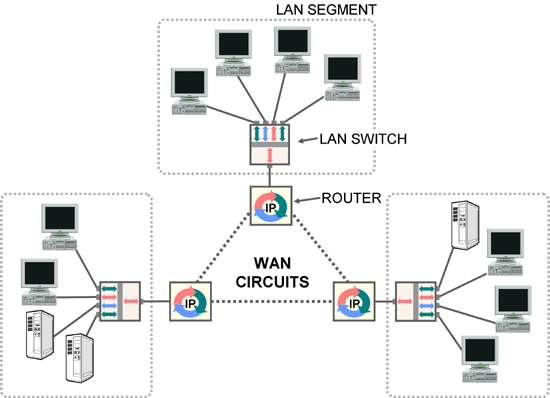Note: This is an archived article that appeared in the Teracom newsletter years ago.
WANs are the biggest growth area in the data communications and computer industries today. LANs are fairly well-understood and stable technology for all connecting together all of the computers in the office. The money is in connecting LANs in different buildings together.
The definition of a WAN is connecting LANs in different locations together with data circuits. For reasons of availability, we often connect the sites with redundant paths, so that there is more than one way to get from "A" to "C". For this reason, we need equipment at each site which is capable of making a route decision: which route to take to get to the desired destination.

What would be a good name for a box which can make route decisions? How about a router, for example.
We have to give the router some information to use to make the routing decisions. The most popular strategy is to assign network addresses to all of the computers. When one wishes to send a block of data to another computer, one puts the destination's network address on the front of the block, forming a packet, which is sent to the router. The router looks at the network address and uses this as the basis of making a route decision.
There used to be a few choices for addressing, routing and end-to-end error checking protocols. The TCP/IP suite of protocols, which includes the Transmission Control Protocol (TCP) and the Internet Protocol (IP) are now the most popular and have gained worldwide acceptance.
There are many choices for the data circuits used to connect the sites together, including wireless, fiber and copper, and many services offered by common carriers, including IP packet communications managed with behind the scenes with MPLS: Internet service, Internet SD-WANs, and on private networks, called "MPLS Services".
Related Courses
These topics are covered in online certification courses:- TCO CTNS Certified Telecommunications Network Specialist – Course 2211 LANs, VLANs, Wireless and Optical Ethernet
- TCO CTNS Certified Telecommunications Network Specialist – Course 2213 IP Networks, Routers and Addresses
- TCO CTA Certified Telecommunications Analyst – Course 2407 Introduction to Datacom and Networking
- TCO CTA Certified Telecommunications Analyst – Course 2408 Data Coding, Frames and Packets
- TCO CTA Certified Telecommunications Analyst – Course 2411 LANs, VLANs, Wireless and Optical Ethernet
- TCO CTA Certified Telecommunications Analyst – Course 2413 IP Addresses, Packets and Routers









